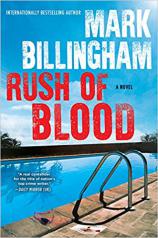Rush of Blood
Review
Rush of Blood
RUSH OF BLOOD is a very different book for Mark Billingham. A stand-alone work taking place almost entirely outside of the purview of his Tom Thorne series, it is his first novel to take place (though partially so) in the United States. Of greater note, though, is that Billingham one-foots into the domestic thriller genre while remaining firmly planted in police procedural with the other. The result is a work intended to keep the reader guessing and reading through multiple changes of time, place and, most particularly, point of view.
The book focuses primarily on three couples --- Angie and Barry, Sue and Ed, Marina and Dave --- who meet while vacationing at a resort in Sarasota, Florida. The thread that connects them is that they are all English. They gravitate, connect and socialize, the ultimate glue being a bit of subtle and aggressive cheerfulness from Ed, whose “hail fellow well met” demeanor is delivered with an occasional sharp elbow. On the day before they are scheduled to depart, a 14-year-old girl named Amber-Marie, who has special needs and is staying at the same resort with her mother, goes missing. The three couples are questioned, as are many others at the resort, but return to England the following day.
"...a work intended to keep the reader guessing and reading through multiple changes of time, place and, most particularly, point of view."
The investigation into Amber-Marie’s disappearance continues, run by Jeff Gardner, a world-weary but dedicated homicide investigator. Angie initiates the first of three dinner parties --- one at each couple’s home --- while also keeping tabs on what is occurring in the hunt for Amber-Marie. When the search ends --- tragically but not unexpectedly --- Gardner, in the interest of completeness, informs his British law enforcement counterparts to contact the three couples and obtain answers to a few follow-up questions concerning their observations of Amber-Marie. Jenny Quinlan, a young trainee constable, is tasked with the job, which ordinarily would be considered scutwork. Quinlan, though, is very much the eager beaver, and begins investigating the case herself when her correspondence with the vacationers indicate that each and all of them, if not lying, are not telling the full truth, either.
Meanwhile, the dinner parties continue to roll out and the couples stay in touch, even as each new contact among them reveals some discomforting facts that everyone involved wish had stayed concealed. In the interim, it becomes very clear to the reader that one of the six is responsible not only for Amber-Marie’s death but also for the disappearance and murder of another girl of similar difficulties in an area near London. Quinlan picks, pokes and prods until something gives, and does it ever. The main course at the third dinner party is revelation of a sorts, served up rare.
The narrative of RUSH OF BLOOD moves back and forth in time and place, alternating among the members of the three couples, Quinlan, Gardner and the murderer, whose identity is not revealed until the story’s conclusion. The format moves the proceedings along and certainly makes the reader pay attention, given that each chapter shifts things, including perspective, time and place. A character familiar to Billingham’s fan base makes a cameo appearance near the end of the book, leaving the door open for the possibility, however slight, that a potential sequel might intersect with the Tom Thorne series. Fingers crossed.
Reviewed by Joe Hartlaub on February 10, 2017





